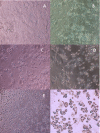Screening of anti-dengue activity in methanolic extracts of medicinal plants
- PMID: 22244370
- PMCID: PMC3269354
- DOI: 10.1186/1472-6882-12-3
Screening of anti-dengue activity in methanolic extracts of medicinal plants
Abstract
Background: Dengue fever regardless of its serotypes has been the most prevalent arthropod-borne viral diseases among the world population. The development of a dengue vaccine is complicated by the antibody-dependent enhancement effect. Thus, the development of a plant-based antiviral preparation promises a more potential alternative in combating dengue disease.
Methods: Present studies investigated the antiviral effects of standardised methanolic extracts of Andrographis paniculata, Citrus limon, Cymbopogon citratus, Momordica charantia, Ocimum sanctum and Pelargonium citrosum on dengue virus serotype 1 (DENV-1).
Results: O. sanctum contained 88.6% of total flavonoids content, an amount that was the highest among all the six plants tested while the least was detected in M. charantia. In this study, the maximum non-toxic dose (MNTD) of the six medicinal plants was determined by testing the methanolic extracts against Vero E6 cells in vitro. Studies also determined that the MNTD of methanolic extract was in the decreasing order of M. charantia >C. limon >P. citrosum, O. sanctum >A. paniculata >C. citratus. Antiviral assay based on cytopathic effects (CPE) denoted by degree of inhibition upon treating DENV1-infected Vero E6 cells with MNTD of six medicinal plants showed that A. paniculata has the most antiviral inhibitory effects followed by M. charantia. These results were further verified with an in vitro inhibition assay using MTT, in which 113.0% and 98.0% of cell viability were recorded as opposed to 44.6% in DENV-1 infected cells. Although methanolic extracts of O. sanctum and C. citratus showed slight inhibition effect based on CPE, a significant inhibition was not reflected in MTT assay. Methanolic extracts of C. limon and P. citrosum did not prevent cytopathic effects or cell death from DENV-1.
Conclusions: The methanol extracts of A. paniculata and M. charantia possess the ability of inhibiting the activity of DENV-1 in in vitro assays. Both of these plants are worth to be further investigated and might be advantageous as an alternative for dengue treatment.
Figures




References
Publication types
MeSH terms
Substances
LinkOut - more resources
Full Text Sources
Medical
Research Materials
Miscellaneous

